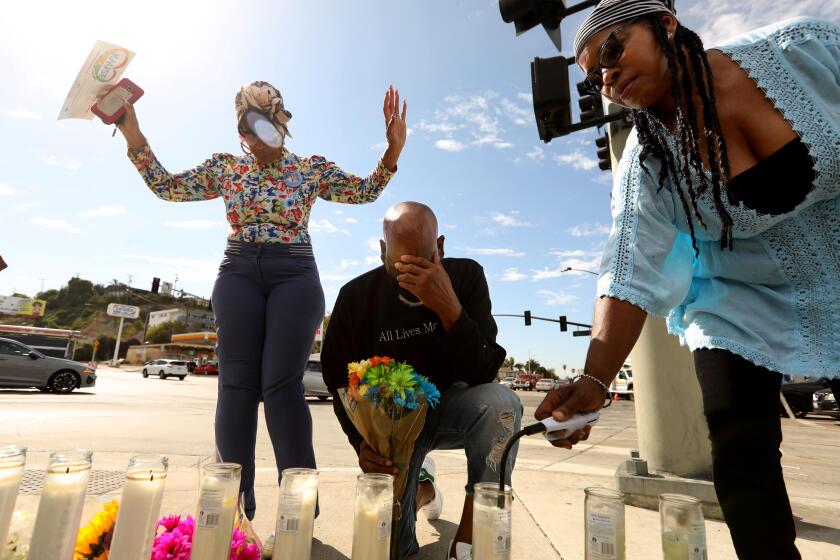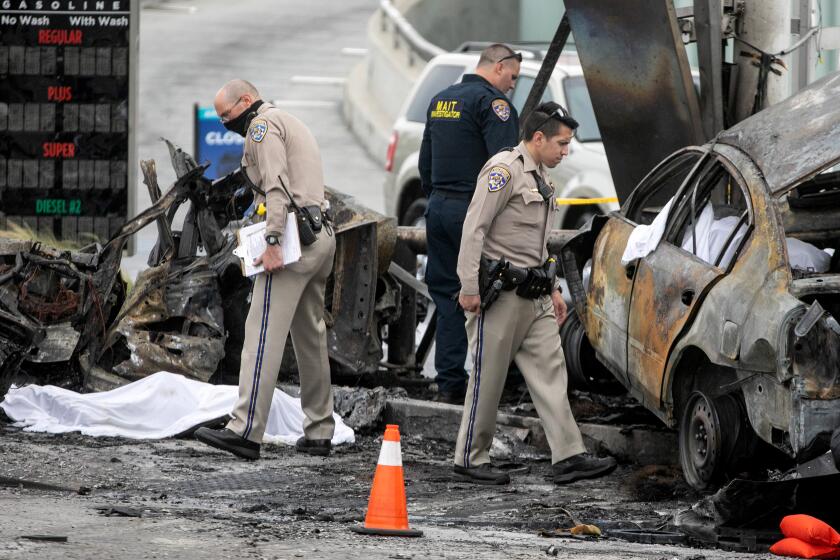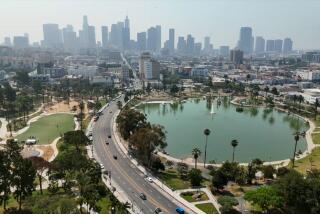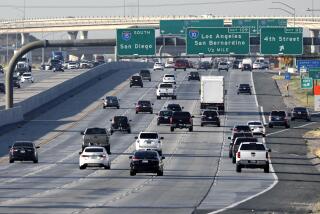Column: Speeding, racing, street takeovers and the deadly toll on L.A. streets
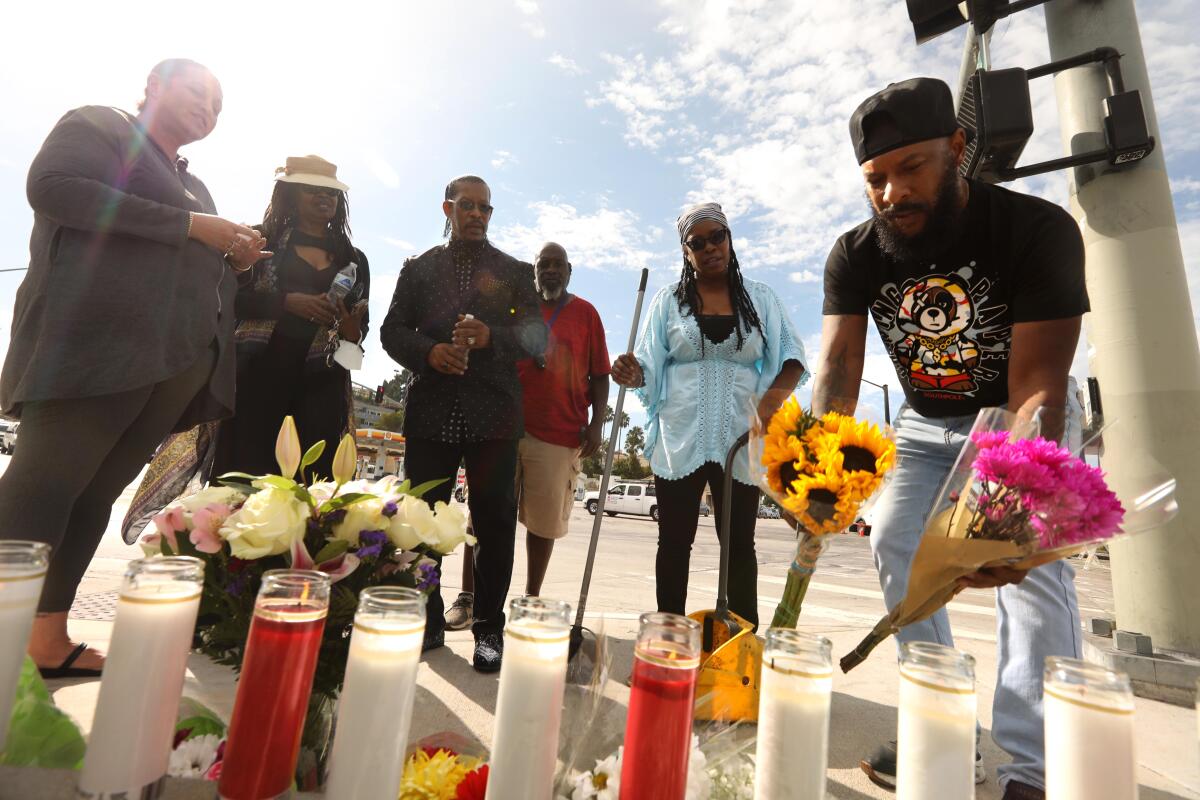
- Share via
Dr. Mark Morocco was on duty in the emergency room at UCLA’s Ronald Reagan Medical Center when it happened. He told me the staff was alerted and began preparing for incoming patients — girding for the worst.
In Los Angeles, one collision is more grisly than the last, it seems. Vehicles are dismembered, debris goes airborne, car parts and people are incinerated in fireballs.
This time, on Thursday afternoon, it happened at the intersection of Slauson and La Brea avenues in Windsor Hills. Police say the driver of a Mercedes, traveling at a speed between 80 and 100 mph, blew through a red light. The smoldering wreckage looked like something you’d expect to see after an aerial bombing raid.
“The take-home thing is that the faster you go, the more all bets are off,” said Morocco. “There’s a speed limit for a reason, and the faster you go, the more things happen that are all bad.”
As it turned out, several patients arrived at the ER, but only one was seriously injured.
The rest were dead at the scene.
Morocco, who later saw footage of the wreck, said it was like so many others in which people are gone before they know what hit them.
“People have their necks broken, they burn to death and suffer unrecoverable injuries. The onus for care drops into the laps of firefighters and paramedics … and even those guys, with all their equipment and training, can’t do anything,” Morocco said.
“I see 80-mph drivers every day between my house and UCLA,” Morocco said. “And that’s on surface streets, 2.3 miles.”
A registered nurse has been arrested and will be booked on vehicular manslaughter charges in the fiery Windsor Hills car crash that killed five people.
And each night, from his home in West L.A., there’s a symphony of speed and horsepower.
“All night we hear blown racing exhausts up and down Olympic and Pico,” Morocco said. “All night every night.”
It’s terrifyingly common in Los Angeles, and getting behind the wheel, or going for a walk or a bike ride, is a game of roulette.
Morocco once ran onto his street after a neighbor was mowed down by a car. He knew it looked bad and told his wife, Lisa Waltz, to run back home and get a sharp kitchen knife so he could perform surgery if necessary before paramedics arrived. The neighbor didn’t make it.
In February 2021, Waltz and Morocco heard the thunder of a nearby collision. Waltz ran to Olympic, where a teenager in a speeding Lamborghini had plowed into a car driven by Monique Munoz, 32, a UCLA office assistant who wanted to become an attorney. Waltz ran back to get Morocco, telling him it was really bad.
“It looked like a war zone,” said Morocco, who rushed to Munoz’s aid. She’d been in a car that no longer resembled a car. “I held her head in my hands while she died. She died at the top of my street because someone was going a hundred-plus miles an hour.”
A month after that senseless tragedy, I attended a memorial service on the one-year anniversary of another victim of road violence. Sixty-eight-year-old psychologist Larry Brooks had gone for a midday walk in his Arts District neighborhood and didn’t make it home.
His wife of 34 years, Anna Marie Piersimoni, heard sirens and then a knock at her door. Police told her that her husband was gone. A 23-year-old driver in a speeding McLaren sports car had lost control and killed Brooks on the spot.
Piersimoni told me “vehicular weaponry run amok” had killed her husband, who was beloved by many and had worked with children in underserved communities. The driver who hit him was sentenced to six months behind bars, but was released after serving less than three months, Piersimoni said. Her civil suits against the driver and the city are pending, the latter alleging that needed road safety improvements had not been made despite complaints from residents.
Isaac Cardona, Munoz’s stepfather, told me that the street where she died “isn’t a raceway. It’s a residential street, with a speed limit.”
Speed limits mean nothing in a place where too many people think “Fast and Furious” was a driver’s ed film, and enforcement is all too rare. L.A. Mayor Eric Garcetti rolled out Vision Zero in 2015, with a goal of ending traffic deaths by 2025. But 21% more people died in 2021 than in 2020, with nearly 300 fatalities. And critics say the effort to create safer streets through engineering, enforcement, education, evaluation and community engagement has been underwhelming.
“We know how to make roads safer. It’s not rocket science. It’s actually quite simple. But we don’t have enough political leaders who will stand up,” said Damian Kevitt, who lost his right leg below the knee in 2013 when he was struck near the zoo in Griffith Park while riding a bike.
Kevitt, who started the nonprofit advocacy group Streets Are for Everyone after his near-death experience, has admonished me not to refer to such incidents as accidents. Selfish, negligent, dangerous driving is a choice, he says. As is driving under the influence, which is all too common. And the largest single factor in fatal collisions, he said, is speed.
“We’re so concerned about regulating guns,” Kevitt said, and of course, we should be. “But it’s perfectly acceptable for people to drive in a reckless fashion with something just as deadly as a gun, and to commit the equivalent of a mass shooting by driving through an intersection with their vehicle.”
It’s not acceptable, but we haven’t done enough about it. Kevitt said the re-engineering of streets with roundabouts, speed bumps and a host of other tools would slow vehicles and protect cyclists, pedestrians and drivers. City officials have said many improvements have been made, with more work to do.
When I last wrote about Kevitt, he was pushing legislation calling for speed enforcement cameras near schools. The bill died, as did another calling for speed enforcement in areas with high rates of collisions.
Opposition on such attempts has come from police unions perhaps concerned about cameras doing their jobs, from those questioning admissibility in court, and from those arguing against the reliability of surveillance technology or the possibility of citations being sent to vehicle owners who weren’t behind the wheel.
All of which has been addressed in other cities, Kevitt says, and collision rates have fallen in those places. He said not only has he not given up the fight, but he’s storming back, with a growing army of supporters.
“Right now we have a massive influx of victims of traffic violence requesting help, and we’re racing out to try to contact victims in Windsor Hills to provide support. We have policy and legislation issues we’re trying to reformulate … and we’re going to keep doing this,” Kevitt said. “Honestly, we’re going to take the gloves off and start calling names out. We’ve been nice about it, but enough is enough.”
Morocco, by the way, used to be an actor and screenwriter. In 1988, he and Waltz were seriously injured in Pennsylvania in a two-car collision on icy streets. Had their car or the other one been going 10 or 20 mph faster, he said, they might be dead. Morocco, inspired by the trauma surgeon and ER doctor who helped save his life, switched careers. I met him when he was in medical school in Pennsylvania.
A nurse has been arrested on vehicular manslaughter charges in the crash that killed five people, including a pregnant woman, sources confirmed.
Morocco said that at the height of the pandemic, when streets were less congested, he saw a lot of patients injured in high-speed collisions. The return of heavy traffic hasn’t stopped the carnage, and Morocco suspects that something has shifted in the psyche of many people.
In the wake of virus denial, vaccine defiance and a general sense of rebellion against the rule of law, there seems to be a new strain of selfishness and recklessness, Morocco said, all of it made more dangerous by L.A.’s preponderance of big, fast, dangerous vehicles.
It’s as if “everyone is driving like Mario Andretti, everywhere you go,” Morocco said, with brazen road racing and street takeovers. It’s as if we’ve regressed, and the attitude seems to be, “I need to live in the moment and take what is mine. Like caveman behavior.”
Seat belts, air bags and advances in life-saving ER techniques have made many collisions survivable, Morocco said. But those things are no match for tons of metal hurtling like meteors through roads and boulevards.
“Time to take away those people’s cars, one and done, you’re walking now,” Morocco said. “Cruel and unusual punishment? Cruel and unusual is burning to death in your minivan, or having your kids run over in a crosswalk.”
More to Read
Sign up for Essential California
The most important California stories and recommendations in your inbox every morning.
You may occasionally receive promotional content from the Los Angeles Times.

